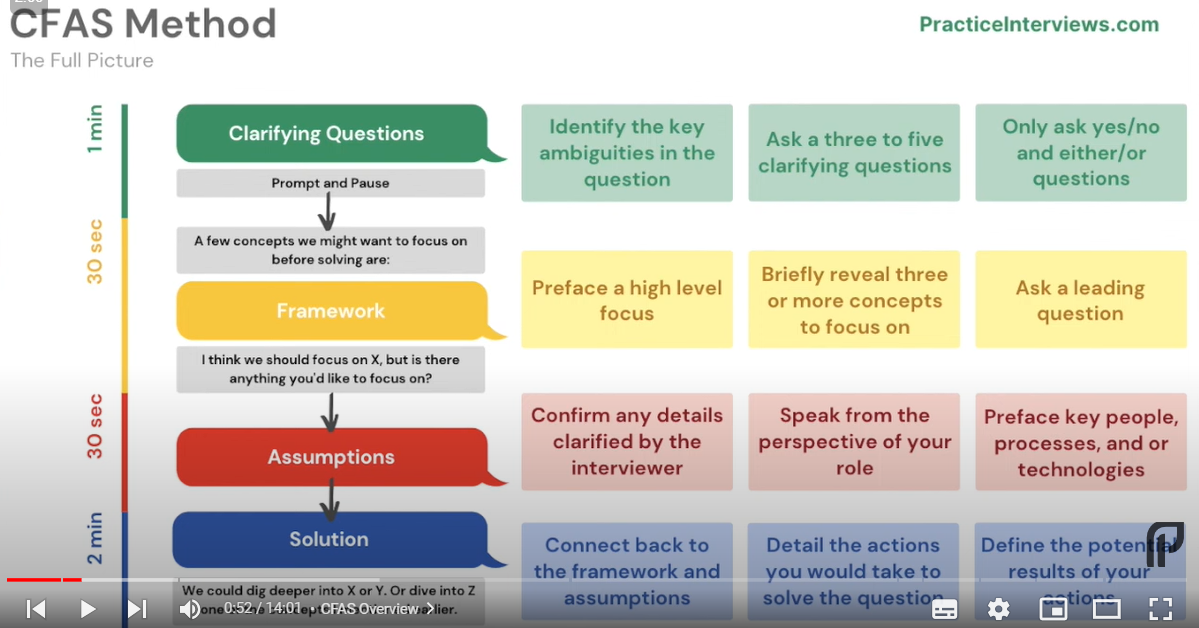Practice Hypothetical Question Style in Behavioral Interview.

There will be hypothetical and open ended questions and company will ask you a how would you, what would you do in X scenario I want you to imagine you’re in y scenario.
On the behavioral side where we have the STAR method for hypothetical and open-ended questions use the CFAST method.
CFAST Clarifying, Framework think of a framework like an outline then we are going to make some role specific Assumptions specifically the role you’re interviewing for and then going to Solve.
Clarifying.
Intro statement before the clarifying question - Before solving I’d like to ask a few clarifying questions.
Ask question by identifying the key ambiguities in the question are there any concepts items words that have some ambiguity ask on those topic. If interviewer is engaged ask like 5 else 3.
Only ask yes/no and either/or type questions. Like frame the question and show all the possibiities you are thinking and then ask which scenario you want to answer.
Framework.
Transition statement before framework - A few concepts we might want to focus on before solving are.
It is an outline it’s your approach to the major Concepts or items that you want to focus on. Framework is like the chapters of the book.
Frameworks that are probably somewhere in the neighborhood of five to seven Concepts but you know a minimum of three for a time of like 30 secs. It should only contains the words and not contains the details.
Will connect those concepts to the core questions and choose 1 - 2 core concepts to begin the solutions.
It might sound like you introduce that transition statement and you may say goals and objectives, historical data, scope and scale, timeline, budget and working with those critical stakeholders are going to be the most important items to focus on. Show the brevity.
Assumptions.
Transition statement before framework - Lets make a few assumptions.
Make role specific assumptions - It helps the interviewer picture you in the role. It should be also very fast like 30 secs.
Confirming any details clarified by the interviewer so if they do answer any of your clarifying questions then picture the role based on the points. Spreak from the perspective of the role. Preface key people, processes and technologies.
Make the role specific and try to solve specific problem like if you are talking about client then mention it is this client who wants to improve their business in this way so the interviewer can portrait yourself in that role. It is easy for you to solve the problem if it is specific.
Solutions.
Transition statement before framework - **I think we should start by focusing in on (pick 1 or 2 framework concepts) but is there another area you’d like to focus in on.
Bring the connection with the framework and you are only solving few points not everything that will help in coming with proper solution and interviewer can see you in specific role.
1 - 2 mmins for the solutions. Focus on couple of concepts and that will take some 30 - 40 secs each like 2 mins for the concepts.
If the solution is more than 2 mins then you are losing the interest of the interviewer.
Follow the steps and keep connected with the framework points.
Detail the action you will take to solve the problem. and define like how you will do it. On the behavoiral question it ask for how you solve the problem to predict your future work in hypothetical role you will do it more specific and add more visuals and the interviewer should picture you in the role so that they hire you.
After Solution.
Transition Statement after Solution - We could dive a little deeper into goals and objectives or historical data(A or B concept of the framework) or we could dive a little bit more into the timeline and budget or is there another area you’d like to focus in (C or D concept of the framework) on so sometimes they’re going to be interested in diving into.
Give them the space they can choose some other points also so ask them. Build strong connectivity with the interviewer.
Solution Discussion.
Transition statement after second solution - We can deep dive into the other concept of the framework or the metrics or the measurements.
Try to go to the finalize statement after the second solution if it is difficult or the interviewer is not active. If they’re really interactive we want to keep going because now our brain’s really connected to our solution and we’re likely doing a great job and each new question is more ambiguity so we want to stick with one question as long as we can.
We can show then the metrics and the measurement and show the success looks like because it’s a good way to wrap things up. take 3 mins of time for this one.
Solution 3.
Transition statement after third solution - Is there anything you want me to discuss like the scope and scale or any other points. Dont ask anything like I am missing out or any specific from them they will simply move on so give them points and ask for the direction.
Give one option to the interviewer if we can continue then see how the interviewer reacts.